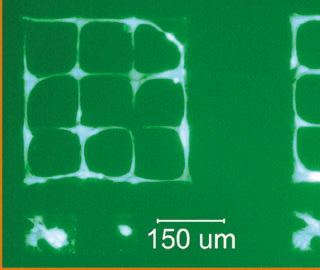The growing area of microelectromechanical systems (MEMS), which integrates mechanical elements, sensors, actuators, and electronics on silicon chips through microfabrication technology, offers many applications. Svetlana Tatic-Lucic, the P.C. Rossin Assistant Professor of electrical and computer engineering, focuses on applying MEMS to cell biology and neurobiology.
In separate NSF projects, Tatic-Lucic studies cell-based sensors and microand nanopatterning of cultured cells. With funding from a CAREER Award, she is designing, building and implementing a Micro Electrode Array (MEA) for extracellular recording from patterned neuronal networks with sensory applications. The arrays, designed to sense changes in cells’ electrical activity, could lead to bioterrorism defense applications, such as detecting the presence of neuroactive agents. The project is a collaboration with Gregory Ferguson, associate professor of chemistry.
The second NSF project, supported by a Nanoscale Exploratory Research (NER) grant, focuses on nanopatterned neuronal networks and integrated fluorescence sensing for biomedical applications. Tatic-Lucic and her students, working with Fil Bartoli, department chair of electrical and computer engineering, use voltage-sensitive dyes to stain cells and watch for the dyes to change colors, indicating electrical activity in the cells. Using optical detectors, they will be able to detect changes in the degree of fluorescence.
In a project funded by NASA and Lehigh, Tatic-Lucic is constructing a MEMS device to determine how the mechanical properties of bone cells change when exposed to different mechanical stimulations or as a function of age. She hopes the project, done in collaboration with Arkady Voloshin and Sudhakar Neti, professors of mechanical engineering and mechanics, leads to a more effective treatment for osteoporosis.
“Biological engineering is a very logical and noble application of MEMS,” says Tatic-Lucic.




